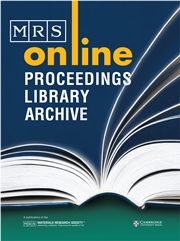No CrossRef data available.
Article contents
Temperature Dependence of Compositional Disordering of Gaas-Alas Superlattices During Mev Kr Irradiation
Published online by Cambridge University Press: 28 February 2011
Abstract
The influence of the specimen temperature during MeV Kr irradiation on the extent of compositional disordering in GaAs-AlAs superlattices (SLs) has been determined. We have investigated whether radiation-enhanced diffusion (RED) could be employed to reduce the dose required to completely disorder a SL by ion implanation. Metalorganic chemical vapor deposition grown GaAs-AlAs SLs were implanted with 0.75 MeV Kr to a dose of 2×1016 cm−2 at various sample temperatures ranging from 133 K to 523 K. The extent of disordering induced by the irradiations was determined by Rutherford backscattering spectrometry and secondary ion mass spectrometry. For low temperature irradiations (133 K to 233 K), complete intermixing of the SL is observed. However, the extent of intermixing of the SL decreases with increasing specimen temperature between room temperature and 523 K. We propose two possible explanations to interpret these results: (i) that the amount of ion beam mixing decreases with increasing temperature; and (ii) that the RED coefficient is negative which suggests the existence of a miscibility gap in the GaAs-AlAs SL system.
Information
- Type
- Research Article
- Information
- Copyright
- Copyright © Materials Research Society 1990

